Iroquois, IL Map & Demographics
Iroquois Map
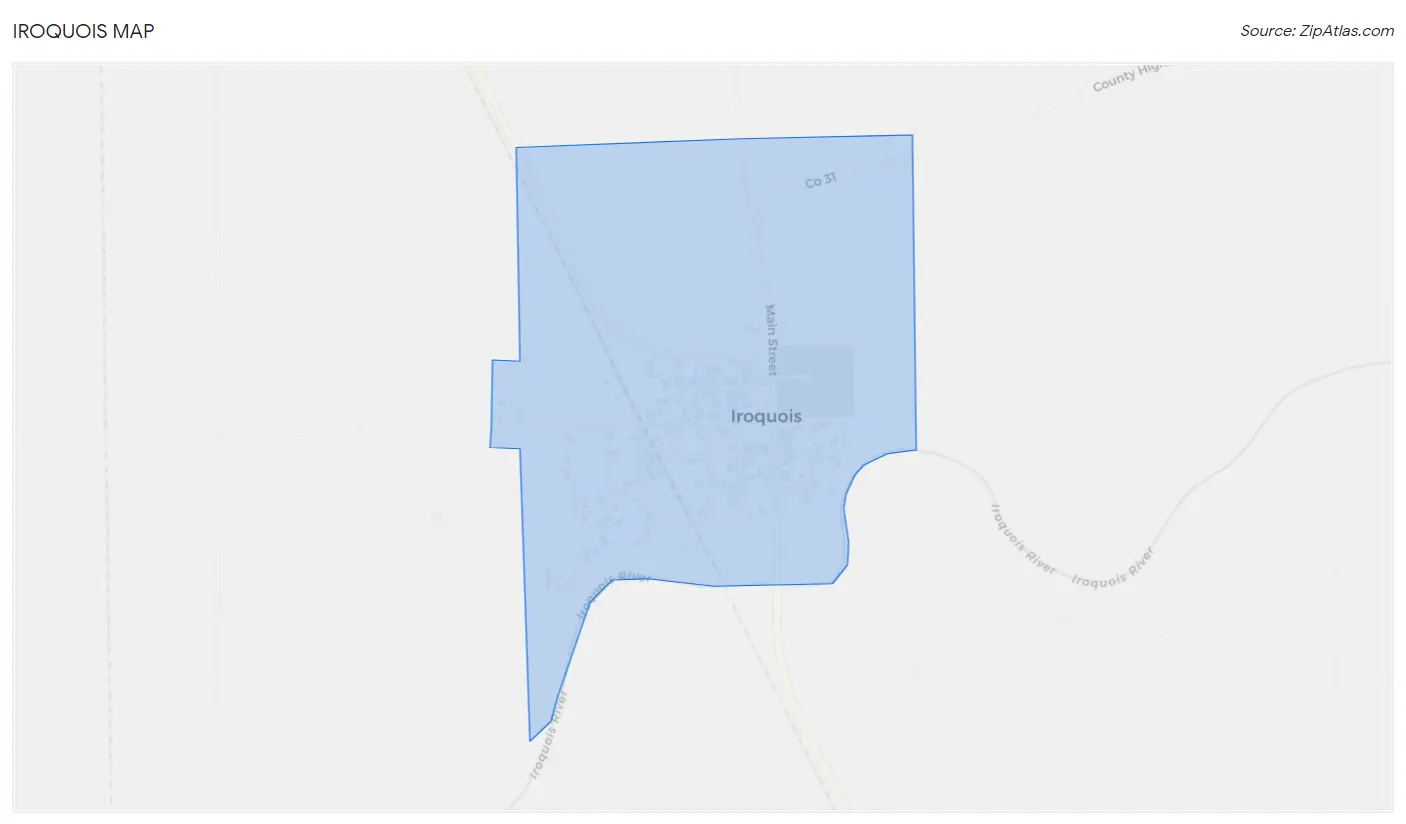
Iroquois Overview
$26,994
PER CAPITA INCOME
$83,750
AVG FAMILY INCOME
$60,000
AVG HOUSEHOLD INCOME
59.9%
WAGE / INCOME GAP [ % ]
40.1¢/ $1
WAGE / INCOME GAP [ $ ]
0.37
INEQUALITY / GINI INDEX
244
TOTAL POPULATION
95
MALE POPULATION
149
FEMALE POPULATION
63.76
MALES / 100 FEMALES
156.84
FEMALES / 100 MALES
45.5
MEDIAN AGE
3.0
AVG FAMILY SIZE
2.6
AVG HOUSEHOLD SIZE
73
LABOR FORCE [ PEOPLE ]
41.7%
PERCENT IN LABOR FORCE
Iroquois Zip Codes
Income in Iroquois
Income Overview in Iroquois
Per Capita Income in Iroquois is $26,994, while median incomes of families and households are $83,750 and $60,000 respectively.
| Characteristic | Number | Measure |
| Per Capita Income | 244 | $26,994 |
| Median Family Income | 62 | $83,750 |
| Mean Family Income | 62 | $82,715 |
| Median Household Income | 94 | $60,000 |
| Mean Household Income | 94 | $72,754 |
| Income Deficit | 62 | $0 |
| Wage / Income Gap (%) | 244 | 59.86% |
| Wage / Income Gap ($) | 244 | 40.14¢ per $1 |
| Gini / Inequality Index | 244 | 0.37 |
Earnings by Sex in Iroquois
Average Earnings in Iroquois are $42,708, $70,179 for men and $28,173 for women, a difference of 59.9%.

| Sex | Number | Average Earnings |
| Male | 47 (53.4%) | $70,179 |
| Female | 41 (46.6%) | $28,173 |
| Total | 88 (100.0%) | $42,708 |
Earnings by Sex by Income Bracket in Iroquois
The most common earnings brackets in Iroquois are $40,000 to $44,999 for men (14 | 29.8%) and $25,000 to $29,999 for women (14 | 34.2%).
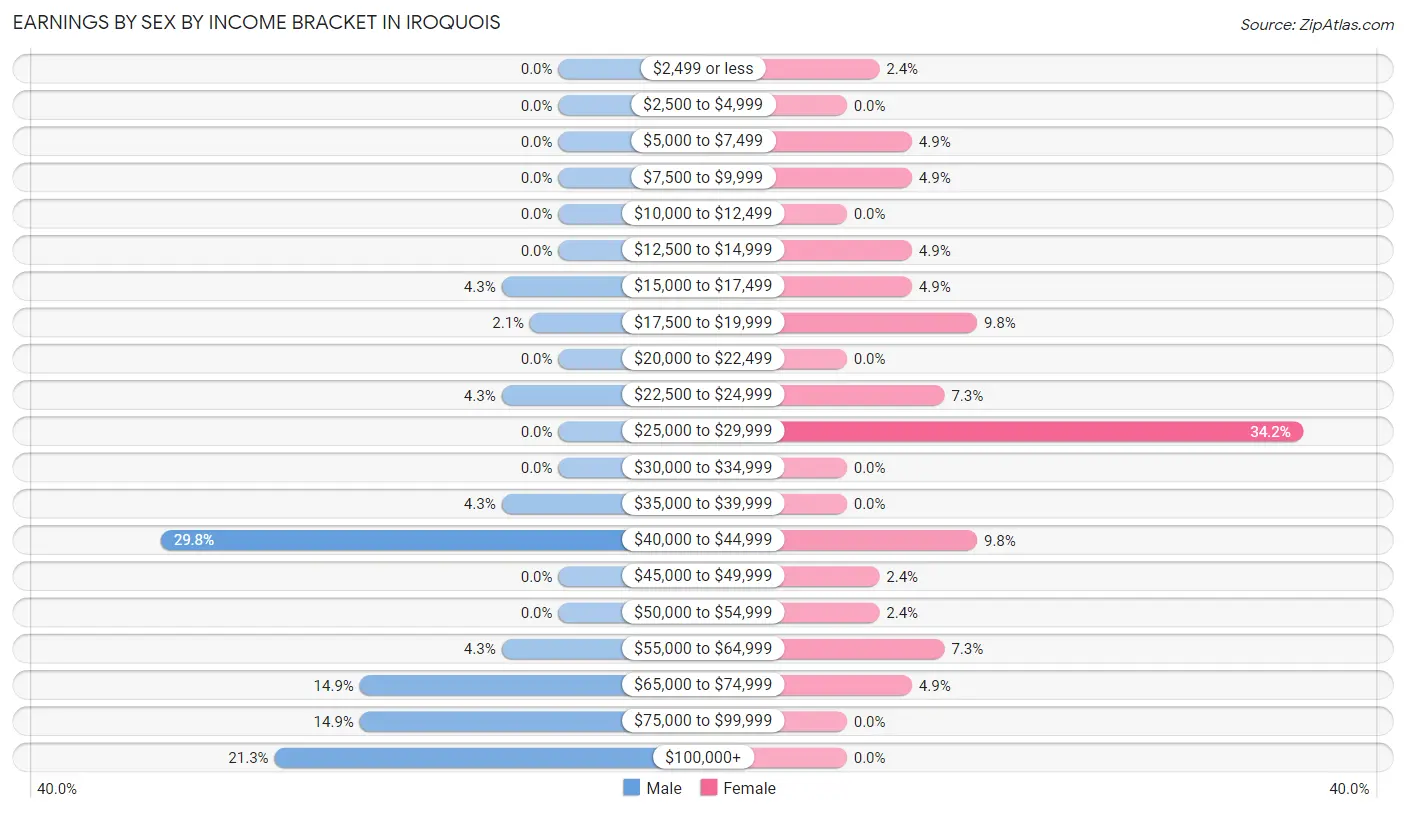
| Income | Male | Female |
| $2,499 or less | 0 (0.0%) | 1 (2.4%) |
| $2,500 to $4,999 | 0 (0.0%) | 0 (0.0%) |
| $5,000 to $7,499 | 0 (0.0%) | 2 (4.9%) |
| $7,500 to $9,999 | 0 (0.0%) | 2 (4.9%) |
| $10,000 to $12,499 | 0 (0.0%) | 0 (0.0%) |
| $12,500 to $14,999 | 0 (0.0%) | 2 (4.9%) |
| $15,000 to $17,499 | 2 (4.3%) | 2 (4.9%) |
| $17,500 to $19,999 | 1 (2.1%) | 4 (9.8%) |
| $20,000 to $22,499 | 0 (0.0%) | 0 (0.0%) |
| $22,500 to $24,999 | 2 (4.3%) | 3 (7.3%) |
| $25,000 to $29,999 | 0 (0.0%) | 14 (34.2%) |
| $30,000 to $34,999 | 0 (0.0%) | 0 (0.0%) |
| $35,000 to $39,999 | 2 (4.3%) | 0 (0.0%) |
| $40,000 to $44,999 | 14 (29.8%) | 4 (9.8%) |
| $45,000 to $49,999 | 0 (0.0%) | 1 (2.4%) |
| $50,000 to $54,999 | 0 (0.0%) | 1 (2.4%) |
| $55,000 to $64,999 | 2 (4.3%) | 3 (7.3%) |
| $65,000 to $74,999 | 7 (14.9%) | 2 (4.9%) |
| $75,000 to $99,999 | 7 (14.9%) | 0 (0.0%) |
| $100,000+ | 10 (21.3%) | 0 (0.0%) |
| Total | 47 (100.0%) | 41 (100.0%) |
Earnings by Sex by Educational Attainment in Iroquois
Average earnings in Iroquois are $70,179 for men and $28,462 for women, a difference of 59.4%. Men with an educational attainment of college or associate's degree enjoy the highest average annual earnings of $72,292, while those with high school diploma education earn the least with $44,500. Women with an educational attainment of bachelor's degree earn the most with the average annual earnings of $42,500, while those with college or associate's degree education have the smallest earnings of $19,375.

| Educational Attainment | Male Income | Female Income |
| Less than High School | - | - |
| High School Diploma | $44,500 | $28,846 |
| College or Associate's Degree | $72,292 | $19,375 |
| Bachelor's Degree | - | - |
| Graduate Degree | - | - |
| Total | $70,179 | $28,462 |
Family Income in Iroquois
Family Income Brackets in Iroquois
According to the Iroquois family income data, there are 20 families falling into the $100,000 to $149,999 income range, which is the most common income bracket and makes up 32.3% of all families.

| Income Bracket | # Families | % Families |
| Less than $10,000 | 0 | 0.0% |
| $10,000 to $14,999 | 1 | 1.6% |
| $15,000 to $24,999 | 6 | 9.7% |
| $25,000 to $34,999 | 1 | 1.6% |
| $35,000 to $49,999 | 5 | 8.1% |
| $50,000 to $74,999 | 16 | 25.8% |
| $75,000 to $99,999 | 10 | 16.1% |
| $100,000 to $149,999 | 20 | 32.3% |
| $150,000 to $199,999 | 3 | 4.8% |
| $200,000+ | 0 | 0.0% |
Family Income by Famaliy Size in Iroquois
3-person families (16 | 25.8%) account for the highest median family income in Iroquois with $115,313 per family, while 3-person families (16 | 25.8%) have the highest median income of $38,438 per family member.

| Income Bracket | # Families | Median Income |
| 2-Person Families | 32 (51.6%) | $65,417 |
| 3-Person Families | 16 (25.8%) | $115,313 |
| 4-Person Families | 13 (21.0%) | $0 |
| 5-Person Families | 1 (1.6%) | $0 |
| 6-Person Families | 0 (0.0%) | $0 |
| 7+ Person Families | 0 (0.0%) | $0 |
| Total | 62 (100.0%) | $83,750 |
Family Income by Number of Earners in Iroquois

| Number of Earners | # Families | Median Income |
| No Earners | 7 (11.3%) | $36,875 |
| 1 Earner | 45 (72.6%) | $83,125 |
| 2 Earners | 4 (6.5%) | $117,500 |
| 3+ Earners | 6 (9.7%) | $0 |
| Total | 62 (100.0%) | $83,750 |
Household Income in Iroquois
Household Income Brackets in Iroquois
With 20 households falling in the category, the $50,000 to $74,999 income range is the most frequent in Iroquois, accounting for 21.3% of all households.

| Income Bracket | # Households | % Households |
| Less than $10,000 | 0 | 0.0% |
| $10,000 to $14,999 | 4 | 4.3% |
| $15,000 to $24,999 | 7 | 7.4% |
| $25,000 to $34,999 | 17 | 18.1% |
| $35,000 to $49,999 | 13 | 13.8% |
| $50,000 to $74,999 | 20 | 21.3% |
| $75,000 to $99,999 | 10 | 10.6% |
| $100,000 to $149,999 | 12 | 12.8% |
| $150,000 to $199,999 | 11 | 11.7% |
| $200,000+ | 0 | 0.0% |
Household Income by Householder Age in Iroquois
The median household income in Iroquois is $60,000, with the highest median household income of $66,500 found in the 45 to 64 years age bracket for the primary householder. A total of 56 households (59.6%) fall into this category.

| Income Bracket | # Households | Median Income |
| 15 to 24 Years | 0 (0.0%) | $0 |
| 25 to 44 Years | 12 (12.8%) | $0 |
| 45 to 64 Years | 56 (59.6%) | $66,500 |
| 65+ Years | 26 (27.7%) | $47,500 |
| Total | 94 (100.0%) | $60,000 |
Poverty in Iroquois
Income Below Poverty by Sex and Age in Iroquois
With 9.5% poverty level for males and 22.8% for females among the residents of Iroquois, 18 to 24 year old males and under 5 year old females are the most vulnerable to poverty, with 5 males (100.0%) and 7 females (100.0%) in their respective age groups living below the poverty level.
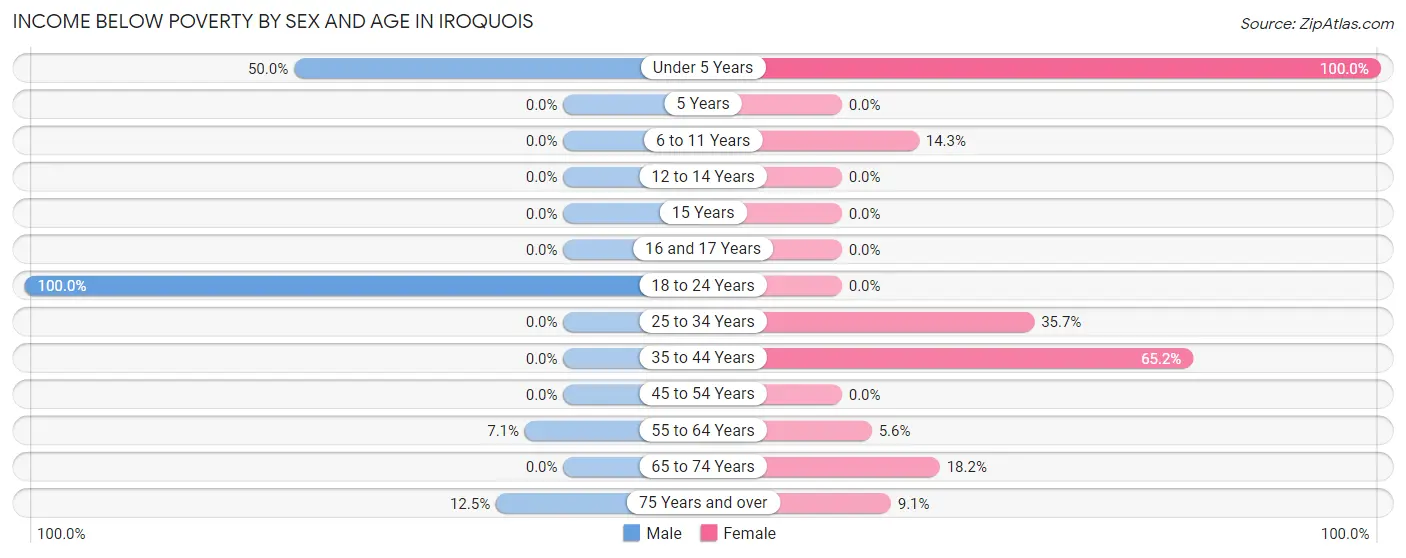
| Age Bracket | Male | Female |
| Under 5 Years | 2 (50.0%) | 7 (100.0%) |
| 5 Years | 0 (0.0%) | 0 (0.0%) |
| 6 to 11 Years | 0 (0.0%) | 3 (14.3%) |
| 12 to 14 Years | 0 (0.0%) | 0 (0.0%) |
| 15 Years | 0 (0.0%) | 0 (0.0%) |
| 16 and 17 Years | 0 (0.0%) | 0 (0.0%) |
| 18 to 24 Years | 5 (100.0%) | 0 (0.0%) |
| 25 to 34 Years | 0 (0.0%) | 5 (35.7%) |
| 35 to 44 Years | 0 (0.0%) | 15 (65.2%) |
| 45 to 54 Years | 0 (0.0%) | 0 (0.0%) |
| 55 to 64 Years | 1 (7.1%) | 1 (5.6%) |
| 65 to 74 Years | 0 (0.0%) | 2 (18.2%) |
| 75 Years and over | 1 (12.5%) | 1 (9.1%) |
| Total | 9 (9.5%) | 34 (22.8%) |
Income Above Poverty by Sex and Age in Iroquois
According to the poverty statistics in Iroquois, males aged 5 years and females aged 5 years are the age groups that are most secure financially, with 100.0% of males and 100.0% of females in these age groups living above the poverty line.
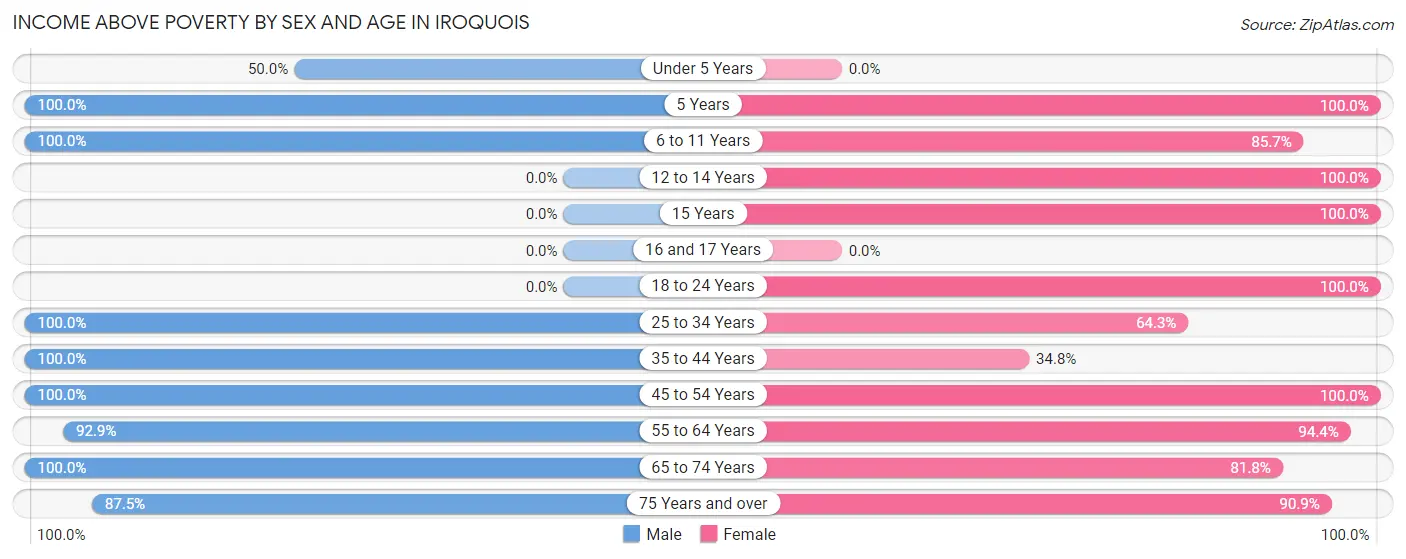
| Age Bracket | Male | Female |
| Under 5 Years | 2 (50.0%) | 0 (0.0%) |
| 5 Years | 1 (100.0%) | 7 (100.0%) |
| 6 to 11 Years | 1 (100.0%) | 18 (85.7%) |
| 12 to 14 Years | 0 (0.0%) | 13 (100.0%) |
| 15 Years | 0 (0.0%) | 15 (100.0%) |
| 16 and 17 Years | 0 (0.0%) | 0 (0.0%) |
| 18 to 24 Years | 0 (0.0%) | 3 (100.0%) |
| 25 to 34 Years | 2 (100.0%) | 9 (64.3%) |
| 35 to 44 Years | 4 (100.0%) | 8 (34.8%) |
| 45 to 54 Years | 39 (100.0%) | 6 (100.0%) |
| 55 to 64 Years | 13 (92.9%) | 17 (94.4%) |
| 65 to 74 Years | 17 (100.0%) | 9 (81.8%) |
| 75 Years and over | 7 (87.5%) | 10 (90.9%) |
| Total | 86 (90.5%) | 115 (77.2%) |
Income Below Poverty Among Married-Couple Families in Iroquois
The poverty statistics for married-couple families in Iroquois show that 2.9% or 1 of the total 35 families live below the poverty line. Families with no children have the highest poverty rate of 3.8%, comprising of 1 families. On the other hand, families with 1 or 2 children have the lowest poverty rate of 0.0%, which includes 0 families.

| Children | Above Poverty | Below Poverty |
| No Children | 25 (96.2%) | 1 (3.8%) |
| 1 or 2 Children | 9 (100.0%) | 0 (0.0%) |
| 3 or 4 Children | 0 (0.0%) | 0 (0.0%) |
| 5 or more Children | 0 (0.0%) | 0 (0.0%) |
| Total | 34 (97.1%) | 1 (2.9%) |
Income Below Poverty Among Single-Parent Households in Iroquois

| Children | Single Father | Single Mother |
| No Children | 0 (0.0%) | 0 (0.0%) |
| 1 or 2 Children | 0 (0.0%) | 2 (100.0%) |
| 3 or 4 Children | 0 (0.0%) | 4 (100.0%) |
| 5 or more Children | 0 (0.0%) | 0 (0.0%) |
| Total | 0 (0.0%) | 6 (60.0%) |
Income Below Poverty Among Married-Couple vs Single-Parent Households in Iroquois
The poverty data for Iroquois shows that 1 of the married-couple family households (2.9%) and 6 of the single-parent households (22.2%) are living below the poverty level. Within the married-couple family households, those with no children have the highest poverty rate, with 1 households (3.8%) falling below the poverty line. Among the single-parent households, those with 3 or 4 children have the highest poverty rate, with 4 household (100.0%) living below poverty.

| Children | Married-Couple Families | Single-Parent Households |
| No Children | 1 (3.8%) | 0 (0.0%) |
| 1 or 2 Children | 0 (0.0%) | 2 (11.8%) |
| 3 or 4 Children | 0 (0.0%) | 4 (100.0%) |
| 5 or more Children | 0 (0.0%) | 0 (0.0%) |
| Total | 1 (2.9%) | 6 (22.2%) |
Race in Iroquois
The most populous races in Iroquois are White / Caucasian (181 | 74.2%), Two or more Races (48 | 19.7%), and Black / African American (15 | 6.1%).

| Race | # Population | % Population |
| Asian | 0 | 0.0% |
| Black / African American | 15 | 6.1% |
| Hawaiian / Pacific | 0 | 0.0% |
| Hispanic or Latino | 0 | 0.0% |
| Native / Alaskan | 0 | 0.0% |
| White / Caucasian | 181 | 74.2% |
| Two or more Races | 48 | 19.7% |
| Some other Race | 0 | 0.0% |
| Total | 244 | 100.0% |
Ancestry in Iroquois
The most populous ancestries reported in Iroquois are German (117 | 47.9%), Irish (79 | 32.4%), American (17 | 7.0%), French (13 | 5.3%), and English (9 | 3.7%), together accounting for 96.3% of all Iroquois residents.
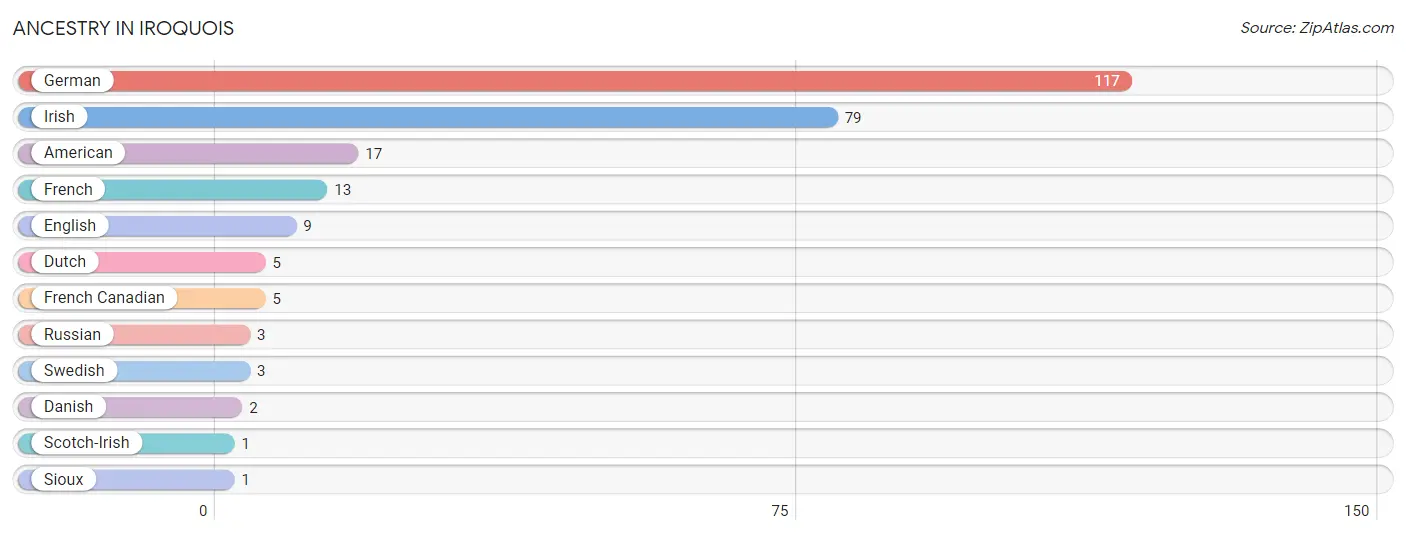
| Ancestry | # Population | % Population |
| American | 17 | 7.0% |
| Danish | 2 | 0.8% |
| Dutch | 5 | 2.1% |
| English | 9 | 3.7% |
| French | 13 | 5.3% |
| French Canadian | 5 | 2.1% |
| German | 117 | 47.9% |
| Irish | 79 | 32.4% |
| Russian | 3 | 1.2% |
| Scotch-Irish | 1 | 0.4% |
| Sioux | 1 | 0.4% |
| Swedish | 3 | 1.2% | View All 12 Rows |
Immigrants in Iroquois
The most numerous immigrant groups reported in Iroquois came from Eastern Europe (1 | 0.4%), Europe (1 | 0.4%), and Russia (1 | 0.4%), together accounting for 1.2% of all Iroquois residents.

| Immigration Origin | # Population | % Population |
| Eastern Europe | 1 | 0.4% |
| Europe | 1 | 0.4% |
| Russia | 1 | 0.4% | View All 3 Rows |
Sex and Age in Iroquois
Sex and Age in Iroquois
The most populous age groups in Iroquois are 50 to 54 Years (22 | 23.2%) for men and 5 to 9 Years (28 | 18.8%) for women.
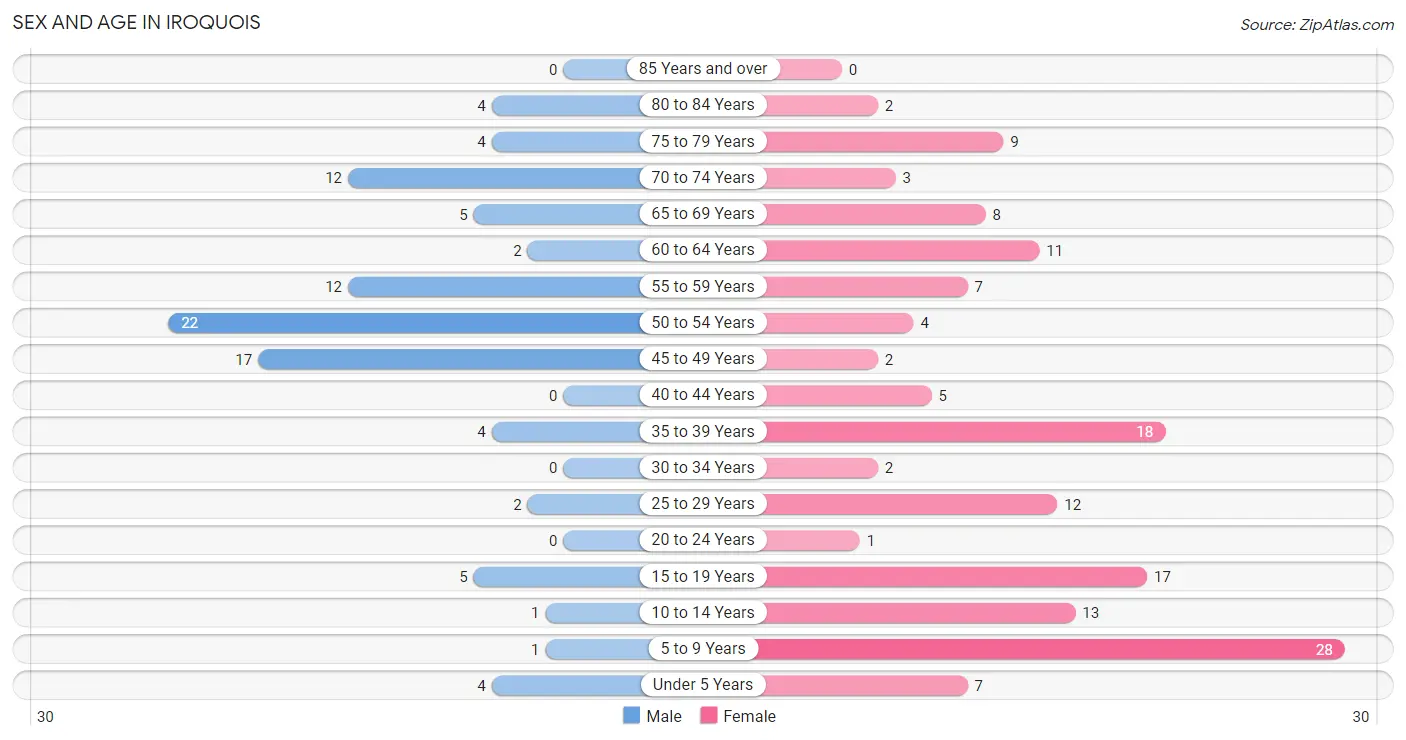
| Age Bracket | Male | Female |
| Under 5 Years | 4 (4.2%) | 7 (4.7%) |
| 5 to 9 Years | 1 (1.1%) | 28 (18.8%) |
| 10 to 14 Years | 1 (1.1%) | 13 (8.7%) |
| 15 to 19 Years | 5 (5.3%) | 17 (11.4%) |
| 20 to 24 Years | 0 (0.0%) | 1 (0.7%) |
| 25 to 29 Years | 2 (2.1%) | 12 (8.1%) |
| 30 to 34 Years | 0 (0.0%) | 2 (1.3%) |
| 35 to 39 Years | 4 (4.2%) | 18 (12.1%) |
| 40 to 44 Years | 0 (0.0%) | 5 (3.4%) |
| 45 to 49 Years | 17 (17.9%) | 2 (1.3%) |
| 50 to 54 Years | 22 (23.2%) | 4 (2.7%) |
| 55 to 59 Years | 12 (12.6%) | 7 (4.7%) |
| 60 to 64 Years | 2 (2.1%) | 11 (7.4%) |
| 65 to 69 Years | 5 (5.3%) | 8 (5.4%) |
| 70 to 74 Years | 12 (12.6%) | 3 (2.0%) |
| 75 to 79 Years | 4 (4.2%) | 9 (6.0%) |
| 80 to 84 Years | 4 (4.2%) | 2 (1.3%) |
| 85 Years and over | 0 (0.0%) | 0 (0.0%) |
| Total | 95 (100.0%) | 149 (100.0%) |
Families and Households in Iroquois
Median Family Size in Iroquois
The median family size in Iroquois is 2.97 persons per family, with single male/father families (17 | 27.4%) accounting for the largest median family size of 3.94 persons per family. On the other hand, single female/mother families (10 | 16.1%) represent the smallest median family size with 2.50 persons per family.

| Family Type | # Families | Family Size |
| Married-Couple | 35 (56.5%) | 2.63 |
| Single Male/Father | 17 (27.4%) | 3.94 |
| Single Female/Mother | 10 (16.1%) | 2.50 |
| Total Families | 62 (100.0%) | 2.97 |
Median Household Size in Iroquois
The median household size in Iroquois is 2.60 persons per household, with single male/father households (17 | 18.1%) accounting for the largest median household size of 4.94 persons per household. non-family households (32 | 34.0%) represent the smallest median household size with 1.34 persons per household.

| Household Type | # Households | Household Size |
| Married-Couple | 35 (37.2%) | 2.63 |
| Single Male/Father | 17 (18.1%) | 4.94 |
| Single Female/Mother | 10 (10.6%) | 2.50 |
| Non-family | 32 (34.0%) | 1.34 |
| Total Households | 94 (100.0%) | 2.60 |
Household Size by Marriage Status in Iroquois
Out of a total of 94 households in Iroquois, 62 (66.0%) are family households, while 32 (34.0%) are nonfamily households. The most numerous type of family households are 2-person households, comprising 32, and the most common type of nonfamily households are 1-person households, comprising 27.

| Household Size | Family Households | Nonfamily Households |
| 1-Person Households | - | 27 (28.7%) |
| 2-Person Households | 32 (34.0%) | 2 (2.1%) |
| 3-Person Households | 1 (1.1%) | 3 (3.2%) |
| 4-Person Households | 28 (29.8%) | 0 (0.0%) |
| 5-Person Households | 1 (1.1%) | 0 (0.0%) |
| 6-Person Households | 0 (0.0%) | 0 (0.0%) |
| 7+ Person Households | 0 (0.0%) | 0 (0.0%) |
| Total | 62 (66.0%) | 32 (34.0%) |
Female Fertility in Iroquois
Fertility by Age in Iroquois
Average fertility rate in Iroquois is 88.0 births per 1,000 women. Women in the age bracket of 20 to 34 years have the highest fertility rate with 267.0 births per 1,000 women. Women in the age bracket of 20 to 34 years acount for 80.0% of all women with births.

| Age Bracket | Women with Births | Births / 1,000 Women |
| 15 to 19 years | 0 (0.0%) | 0.0 |
| 20 to 34 years | 4 (80.0%) | 267.0 |
| 35 to 50 years | 1 (20.0%) | 40.0 |
| Total | 5 (100.0%) | 88.0 |
Fertility by Age by Marriage Status in Iroquois

| Age Bracket | Married | Unmarried |
| 15 to 19 years | 0 (0.0%) | 0 (0.0%) |
| 20 to 34 years | 0 (0.0%) | 4 (100.0%) |
| 35 to 50 years | 0 (0.0%) | 1 (100.0%) |
| Total | 0 (0.0%) | 5 (100.0%) |
Fertility by Education in Iroquois
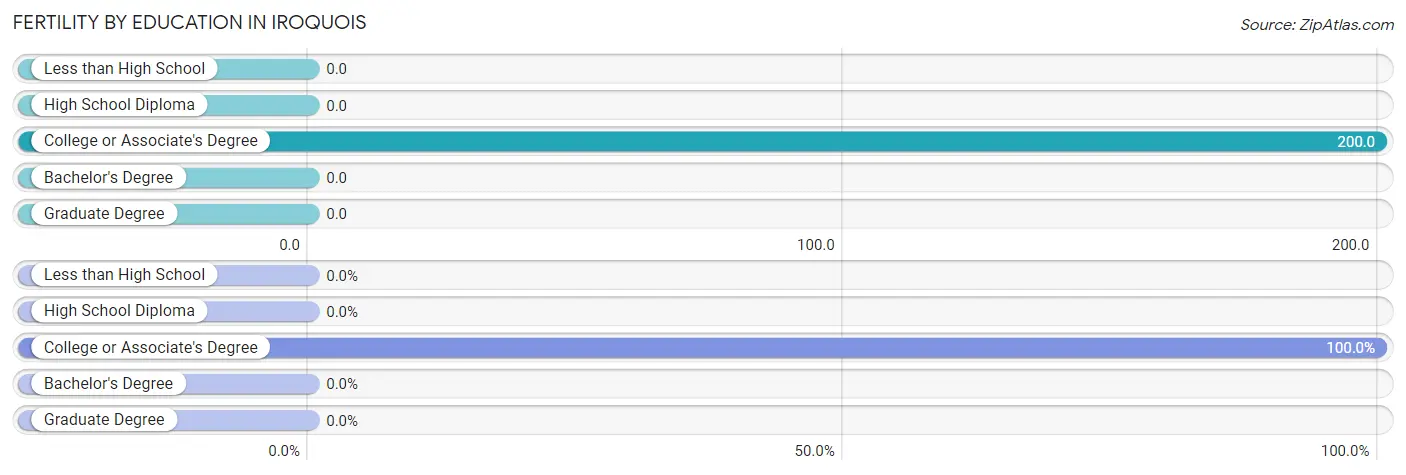
| Educational Attainment | Women with Births | Births / 1,000 Women |
| Less than High School | 0 (0.0%) | 0.0 |
| High School Diploma | 0 (0.0%) | 0.0 |
| College or Associate's Degree | 5 (100.0%) | 200.0 |
| Bachelor's Degree | 0 (0.0%) | 0.0 |
| Graduate Degree | 0 (0.0%) | 0.0 |
| Total | 5 (100.0%) | 88.0 |
Fertility by Education by Marriage Status in Iroquois

| Educational Attainment | Married | Unmarried |
| Less than High School | 0 (0.0%) | 0 (0.0%) |
| High School Diploma | 0 (0.0%) | 0 (0.0%) |
| College or Associate's Degree | 0 (0.0%) | 5 (100.0%) |
| Bachelor's Degree | 0 (0.0%) | 0 (0.0%) |
| Graduate Degree | 0 (0.0%) | 0 (0.0%) |
| Total | 0 (0.0%) | 5 (100.0%) |
Employment Characteristics in Iroquois
Employment by Class of Employer in Iroquois
Among the 73 employed individuals in Iroquois, private company employees (58 | 79.4%), state government employees (8 | 11.0%), and not-for-profit organizations (6 | 8.2%) make up the most common classes of employment.

| Employer Class | # Employees | % Employees |
| Private Company Employees | 58 | 79.4% |
| Self-Employed (Incorporated) | 0 | 0.0% |
| Self-Employed (Not Incorporated) | 1 | 1.4% |
| Not-for-profit Organizations | 6 | 8.2% |
| Local Government Employees | 0 | 0.0% |
| State Government Employees | 8 | 11.0% |
| Federal Government Employees | 0 | 0.0% |
| Unpaid Family Workers | 0 | 0.0% |
| Total | 73 | 100.0% |
Employment Status by Age in Iroquois

| Age Bracket | In Labor Force | Unemployed |
| 16 to 19 Years | 2 (28.6%) | 0 (0.0%) |
| 20 to 24 Years | 1 (100.0%) | 0 (0.0%) |
| 25 to 29 Years | 10 (71.4%) | 0 (0.0%) |
| 30 to 34 Years | 2 (100.0%) | 0 (0.0%) |
| 35 to 44 Years | 9 (33.3%) | 0 (0.0%) |
| 45 to 54 Years | 29 (64.4%) | 0 (0.0%) |
| 55 to 59 Years | 12 (63.2%) | 0 (0.0%) |
| 60 to 64 Years | 8 (61.5%) | 0 (0.0%) |
| 65 to 74 Years | 0 (0.0%) | 0 (0.0%) |
| 75 Years and over | 0 (0.0%) | 0 (0.0%) |
| Total | 73 (41.7%) | 0 (0.0%) |
Employment Status by Educational Attainment in Iroquois

| Educational Attainment | In Labor Force | Unemployed |
| Less than High School | 1 (100.0%) | 0 (0.0%) |
| High School Diploma | 35 (57.4%) | 0 (0.0%) |
| College / Associate Degree | 24 (53.3%) | 0 (0.0%) |
| Bachelor's Degree or higher | 10 (76.9%) | 0 (0.0%) |
| Total | 70 (58.3%) | 0 (0.0%) |
Employment Occupations by Sex in Iroquois
Management, Business, Science and Arts Occupations
The most common Management, Business, Science and Arts occupations in Iroquois are Management (4 | 5.5%), Health Diagnosing & Treating (4 | 5.5%), Business & Financial (2 | 2.7%), Computers, Engineering & Science (1 | 1.4%), and Architecture & Engineering (1 | 1.4%).
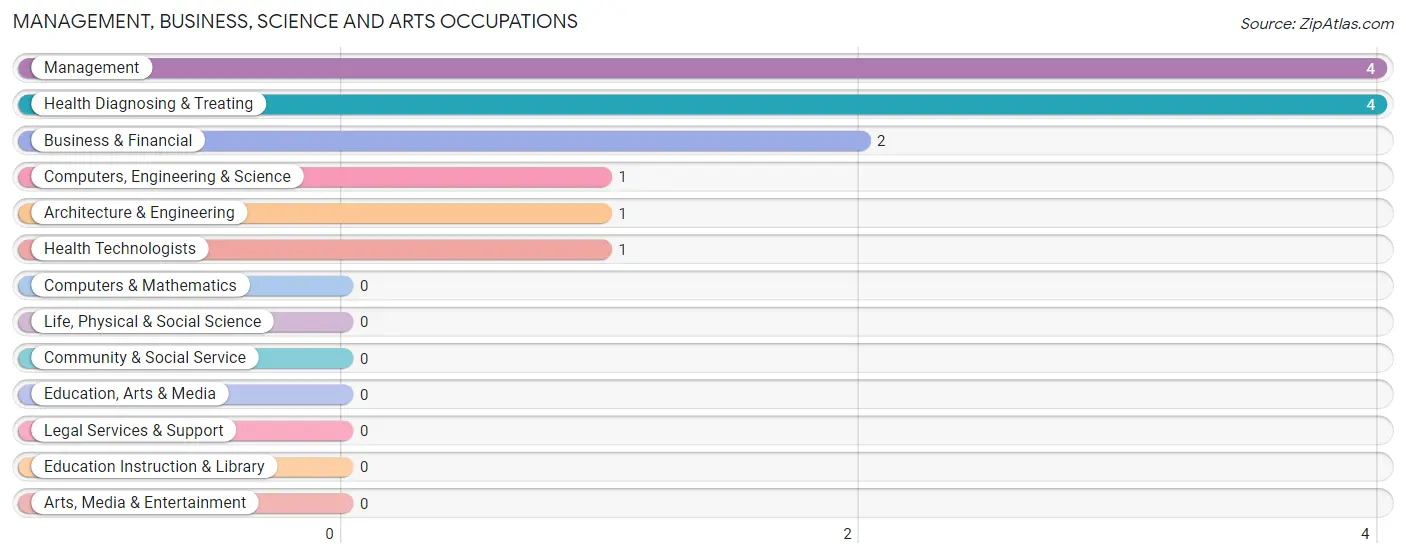
Management, Business, Science and Arts Occupations by Sex
Within the Management, Business, Science and Arts occupations in Iroquois, the most male-oriented occupations are Computers, Engineering & Science (100.0%), Architecture & Engineering (100.0%), and Health Diagnosing & Treating (50.0%), while the most female-oriented occupations are Management (100.0%), Business & Financial (100.0%), and Health Technologists (100.0%).
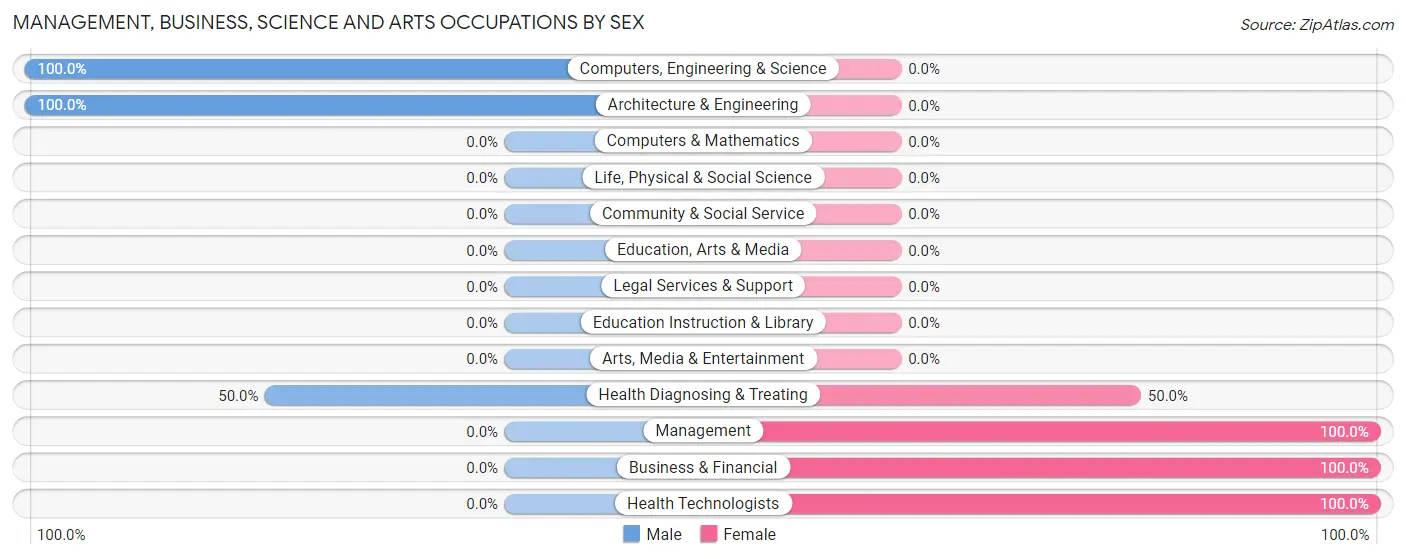
| Occupation | Male | Female |
| Management | 0 (0.0%) | 4 (100.0%) |
| Business & Financial | 0 (0.0%) | 2 (100.0%) |
| Computers, Engineering & Science | 1 (100.0%) | 0 (0.0%) |
| Computers & Mathematics | 0 (0.0%) | 0 (0.0%) |
| Architecture & Engineering | 1 (100.0%) | 0 (0.0%) |
| Life, Physical & Social Science | 0 (0.0%) | 0 (0.0%) |
| Community & Social Service | 0 (0.0%) | 0 (0.0%) |
| Education, Arts & Media | 0 (0.0%) | 0 (0.0%) |
| Legal Services & Support | 0 (0.0%) | 0 (0.0%) |
| Education Instruction & Library | 0 (0.0%) | 0 (0.0%) |
| Arts, Media & Entertainment | 0 (0.0%) | 0 (0.0%) |
| Health Diagnosing & Treating | 2 (50.0%) | 2 (50.0%) |
| Health Technologists | 0 (0.0%) | 1 (100.0%) |
| Total (Category) | 3 (27.3%) | 8 (72.7%) |
| Total (Overall) | 40 (54.8%) | 33 (45.2%) |
Services Occupations
The most common Services occupations in Iroquois are Healthcare Support (11 | 15.1%), and Cleaning & Maintenance (5 | 6.9%).

Services Occupations by Sex

| Occupation | Male | Female |
| Healthcare Support | 2 (18.2%) | 9 (81.8%) |
| Security & Protection | 0 (0.0%) | 0 (0.0%) |
| Firefighting & Prevention | 0 (0.0%) | 0 (0.0%) |
| Law Enforcement | 0 (0.0%) | 0 (0.0%) |
| Food Preparation & Serving | 0 (0.0%) | 0 (0.0%) |
| Cleaning & Maintenance | 5 (100.0%) | 0 (0.0%) |
| Personal Care & Service | 0 (0.0%) | 0 (0.0%) |
| Total (Category) | 7 (43.8%) | 9 (56.2%) |
| Total (Overall) | 40 (54.8%) | 33 (45.2%) |
Sales and Office Occupations
The most common Sales and Office occupations in Iroquois are Office & Administration (23 | 31.5%), and Sales & Related (3 | 4.1%).

Sales and Office Occupations by Sex

| Occupation | Male | Female |
| Sales & Related | 0 (0.0%) | 3 (100.0%) |
| Office & Administration | 15 (65.2%) | 8 (34.8%) |
| Total (Category) | 15 (57.7%) | 11 (42.3%) |
| Total (Overall) | 40 (54.8%) | 33 (45.2%) |
Natural Resources, Construction and Maintenance Occupations
The most common Natural Resources, Construction and Maintenance occupations in Iroquois are Construction & Extraction (5 | 6.9%), Farming, Fishing & Forestry (1 | 1.4%), and Installation, Maintenance & Repair (1 | 1.4%).

Natural Resources, Construction and Maintenance Occupations by Sex

| Occupation | Male | Female |
| Farming, Fishing & Forestry | 0 (0.0%) | 1 (100.0%) |
| Construction & Extraction | 5 (100.0%) | 0 (0.0%) |
| Installation, Maintenance & Repair | 0 (0.0%) | 1 (100.0%) |
| Total (Category) | 5 (71.4%) | 2 (28.6%) |
| Total (Overall) | 40 (54.8%) | 33 (45.2%) |
Production, Transportation and Moving Occupations
The most common Production, Transportation and Moving occupations in Iroquois are Production (10 | 13.7%), and Material Moving (3 | 4.1%).

Production, Transportation and Moving Occupations by Sex

| Occupation | Male | Female |
| Production | 7 (70.0%) | 3 (30.0%) |
| Transportation | 0 (0.0%) | 0 (0.0%) |
| Material Moving | 3 (100.0%) | 0 (0.0%) |
| Total (Category) | 10 (76.9%) | 3 (23.1%) |
| Total (Overall) | 40 (54.8%) | 33 (45.2%) |
Employment Industries by Sex in Iroquois
Employment Industries in Iroquois
The major employment industries in Iroquois include Manufacturing (31 | 42.5%), Health Care & Social Assistance (18 | 24.7%), Finance & Insurance (7 | 9.6%), Construction (4 | 5.5%), and Educational Services (4 | 5.5%).
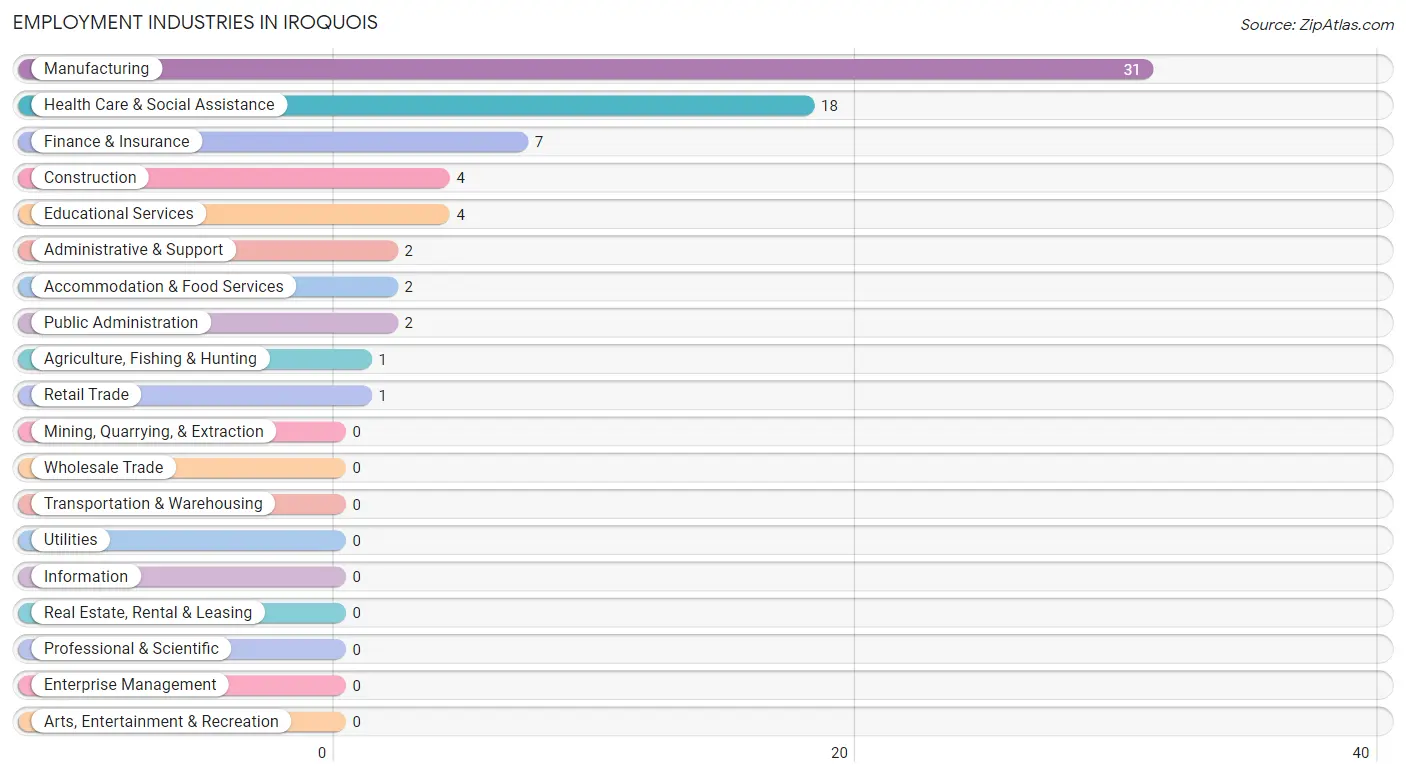
Employment Industries by Sex in Iroquois
The Iroquois industries that see more men than women are Construction (100.0%), Administrative & Support (100.0%), and Educational Services (100.0%), whereas the industries that tend to have a higher number of women are Agriculture, Fishing & Hunting (100.0%), Retail Trade (100.0%), and Finance & Insurance (100.0%).
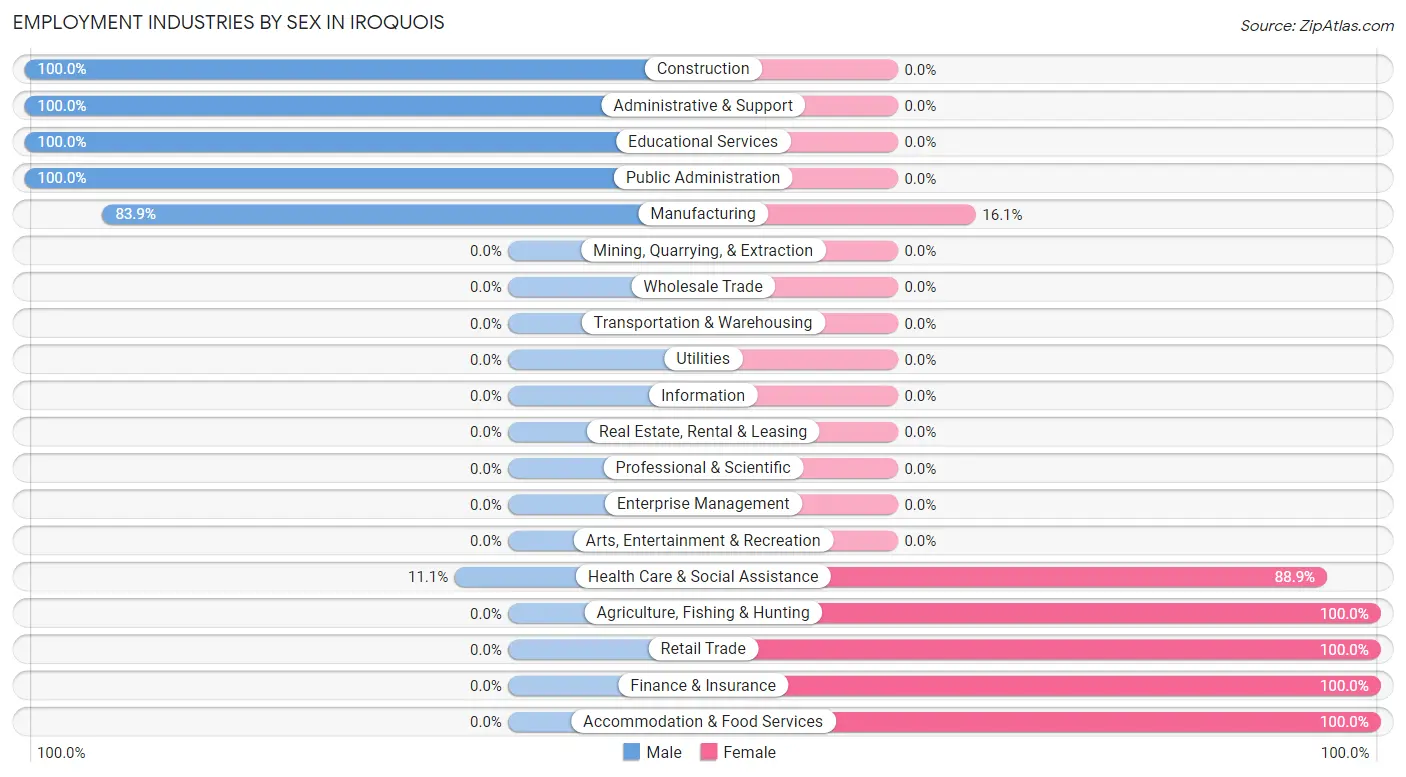
| Industry | Male | Female |
| Agriculture, Fishing & Hunting | 0 (0.0%) | 1 (100.0%) |
| Mining, Quarrying, & Extraction | 0 (0.0%) | 0 (0.0%) |
| Construction | 4 (100.0%) | 0 (0.0%) |
| Manufacturing | 26 (83.9%) | 5 (16.1%) |
| Wholesale Trade | 0 (0.0%) | 0 (0.0%) |
| Retail Trade | 0 (0.0%) | 1 (100.0%) |
| Transportation & Warehousing | 0 (0.0%) | 0 (0.0%) |
| Utilities | 0 (0.0%) | 0 (0.0%) |
| Information | 0 (0.0%) | 0 (0.0%) |
| Finance & Insurance | 0 (0.0%) | 7 (100.0%) |
| Real Estate, Rental & Leasing | 0 (0.0%) | 0 (0.0%) |
| Professional & Scientific | 0 (0.0%) | 0 (0.0%) |
| Enterprise Management | 0 (0.0%) | 0 (0.0%) |
| Administrative & Support | 2 (100.0%) | 0 (0.0%) |
| Educational Services | 4 (100.0%) | 0 (0.0%) |
| Health Care & Social Assistance | 2 (11.1%) | 16 (88.9%) |
| Arts, Entertainment & Recreation | 0 (0.0%) | 0 (0.0%) |
| Accommodation & Food Services | 0 (0.0%) | 2 (100.0%) |
| Public Administration | 2 (100.0%) | 0 (0.0%) |
| Total | 40 (54.8%) | 33 (45.2%) |
Education in Iroquois
School Enrollment in Iroquois
The most common levels of schooling among the 74 students in Iroquois are elementary school (21 | 28.4%), high school (20 | 27.0%), and middle school (14 | 18.9%).

| School Level | # Students | % Students |
| Nursery / Preschool | 13 | 17.6% |
| Kindergarten | 0 | 0.0% |
| Elementary School | 21 | 28.4% |
| Middle School | 14 | 18.9% |
| High School | 20 | 27.0% |
| College / Undergraduate | 6 | 8.1% |
| Graduate / Professional | 0 | 0.0% |
| Total | 74 | 100.0% |
School Enrollment by Age by Funding Source in Iroquois

| Age Bracket | Public School | Private School |
| 3 to 4 Year Olds | 5 (100.0%) | 0 (0.0%) |
| 5 to 9 Year Old | 29 (100.0%) | 0 (0.0%) |
| 10 to 14 Year Olds | 14 (100.0%) | 0 (0.0%) |
| 15 to 17 Year Olds | 15 (100.0%) | 0 (0.0%) |
| 18 to 19 Year Olds | 7 (100.0%) | 0 (0.0%) |
| 20 to 24 Year Olds | 0 (0.0%) | 0 (0.0%) |
| 25 to 34 Year Olds | 4 (100.0%) | 0 (0.0%) |
| 35 Years and over | 0 (0.0%) | 0 (0.0%) |
| Total | 74 (100.0%) | 0 (0.0%) |
Educational Attainment by Field of Study in Iroquois
Arts & humanities (6 | 40.0%), business (3 | 20.0%), science & technology (2 | 13.3%), communications (2 | 13.3%), and bio, nature & agricultural (1 | 6.7%) are the most common fields of study among 15 individuals in Iroquois who have obtained a bachelor's degree or higher.
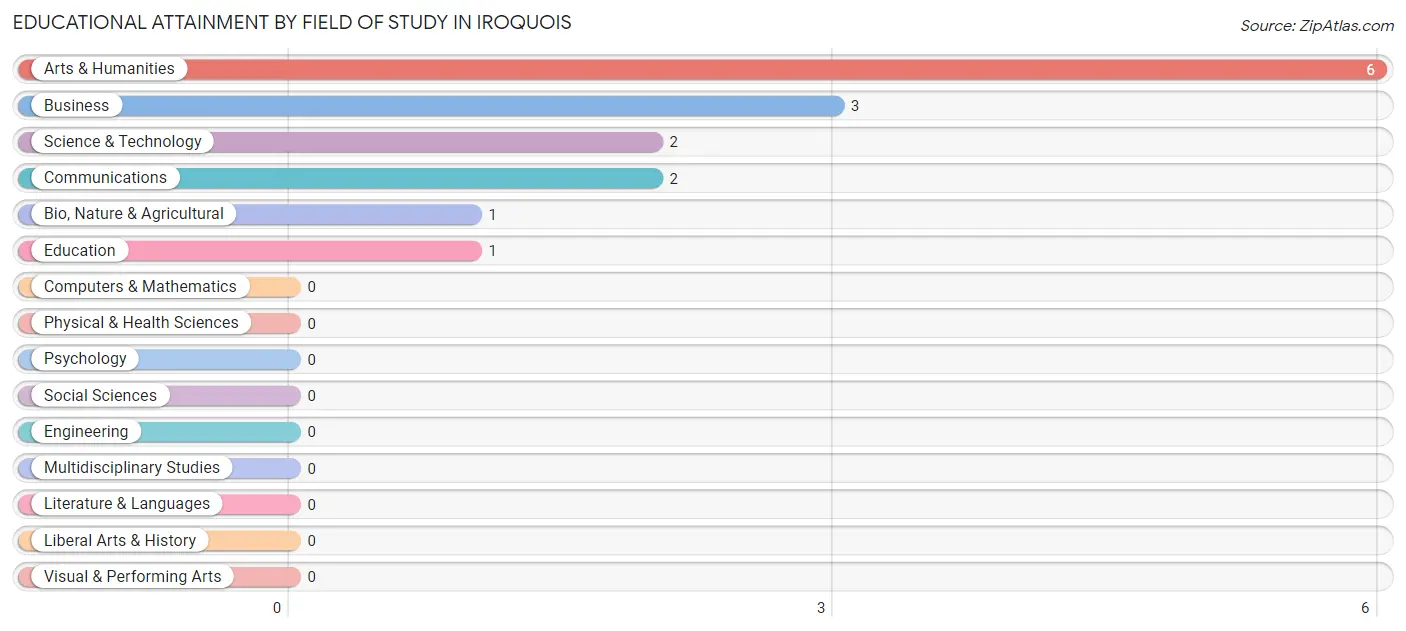
| Field of Study | # Graduates | % Graduates |
| Computers & Mathematics | 0 | 0.0% |
| Bio, Nature & Agricultural | 1 | 6.7% |
| Physical & Health Sciences | 0 | 0.0% |
| Psychology | 0 | 0.0% |
| Social Sciences | 0 | 0.0% |
| Engineering | 0 | 0.0% |
| Multidisciplinary Studies | 0 | 0.0% |
| Science & Technology | 2 | 13.3% |
| Business | 3 | 20.0% |
| Education | 1 | 6.7% |
| Literature & Languages | 0 | 0.0% |
| Liberal Arts & History | 0 | 0.0% |
| Visual & Performing Arts | 0 | 0.0% |
| Communications | 2 | 13.3% |
| Arts & Humanities | 6 | 40.0% |
| Total | 15 | 100.0% |
Transportation & Commute in Iroquois
Vehicle Availability by Sex in Iroquois
The most prevalent vehicle ownership categories in Iroquois are males with 3 vehicles (14, accounting for 35.0%) and females with 3 vehicles (8, making up 42.4%).

| Vehicles Available | Male | Female |
| No Vehicle | 0 (0.0%) | 0 (0.0%) |
| 1 Vehicle | 4 (10.0%) | 9 (27.3%) |
| 2 Vehicles | 3 (7.5%) | 11 (33.3%) |
| 3 Vehicles | 14 (35.0%) | 8 (24.2%) |
| 4 Vehicles | 7 (17.5%) | 2 (6.1%) |
| 5 or more Vehicles | 12 (30.0%) | 3 (9.1%) |
| Total | 40 (100.0%) | 33 (100.0%) |
Commute Time in Iroquois
The most frequently occuring commute durations in Iroquois are 40 to 44 minutes (17 commuters, 23.3%), 45 to 59 minutes (11 commuters, 15.1%), and 15 to 19 minutes (10 commuters, 13.7%).
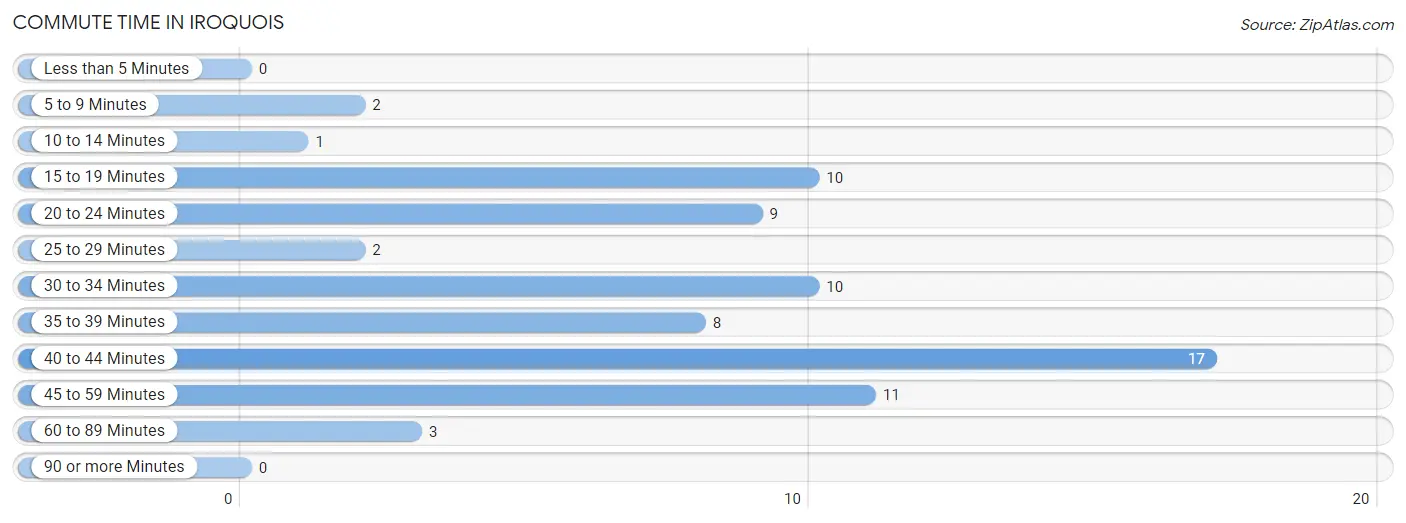
| Commute Time | # Commuters | % Commuters |
| Less than 5 Minutes | 0 | 0.0% |
| 5 to 9 Minutes | 2 | 2.7% |
| 10 to 14 Minutes | 1 | 1.4% |
| 15 to 19 Minutes | 10 | 13.7% |
| 20 to 24 Minutes | 9 | 12.3% |
| 25 to 29 Minutes | 2 | 2.7% |
| 30 to 34 Minutes | 10 | 13.7% |
| 35 to 39 Minutes | 8 | 11.0% |
| 40 to 44 Minutes | 17 | 23.3% |
| 45 to 59 Minutes | 11 | 15.1% |
| 60 to 89 Minutes | 3 | 4.1% |
| 90 or more Minutes | 0 | 0.0% |
Commute Time by Sex in Iroquois
The most common commute times in Iroquois are 40 to 44 minutes (13 commuters, 32.5%) for males and 20 to 24 minutes (9 commuters, 27.3%) for females.
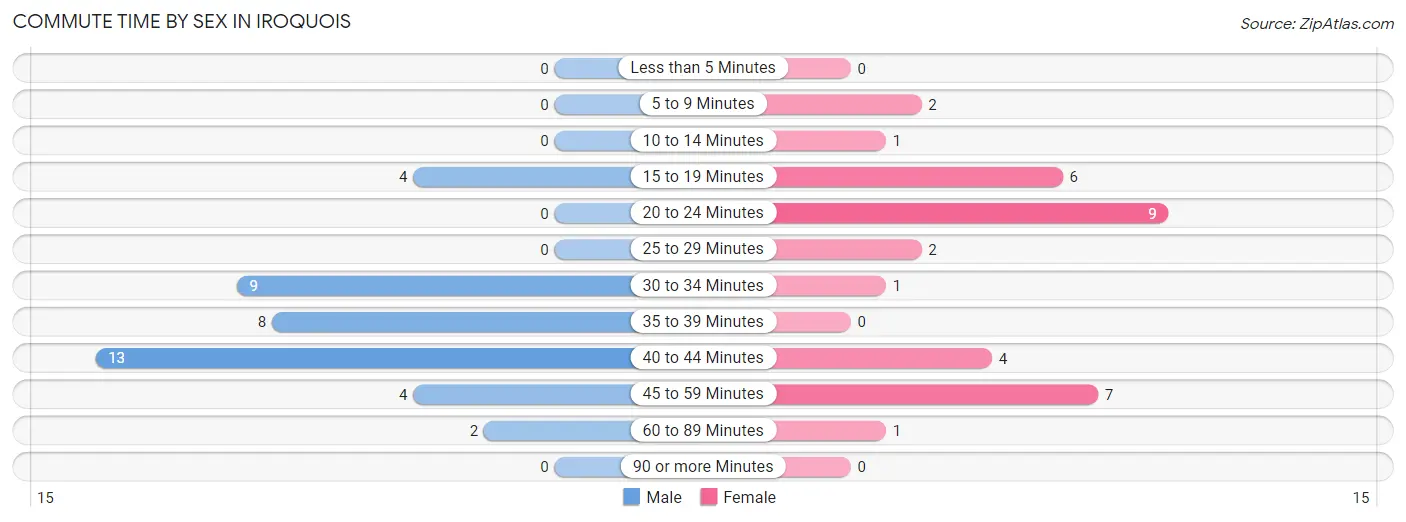
| Commute Time | Male | Female |
| Less than 5 Minutes | 0 (0.0%) | 0 (0.0%) |
| 5 to 9 Minutes | 0 (0.0%) | 2 (6.1%) |
| 10 to 14 Minutes | 0 (0.0%) | 1 (3.0%) |
| 15 to 19 Minutes | 4 (10.0%) | 6 (18.2%) |
| 20 to 24 Minutes | 0 (0.0%) | 9 (27.3%) |
| 25 to 29 Minutes | 0 (0.0%) | 2 (6.1%) |
| 30 to 34 Minutes | 9 (22.5%) | 1 (3.0%) |
| 35 to 39 Minutes | 8 (20.0%) | 0 (0.0%) |
| 40 to 44 Minutes | 13 (32.5%) | 4 (12.1%) |
| 45 to 59 Minutes | 4 (10.0%) | 7 (21.2%) |
| 60 to 89 Minutes | 2 (5.0%) | 1 (3.0%) |
| 90 or more Minutes | 0 (0.0%) | 0 (0.0%) |
Time of Departure to Work by Sex in Iroquois
The most frequent times of departure to work in Iroquois are 4:00 PM to 11:59 PM (12, 30.0%) for males and 7:00 AM to 7:29 AM (9, 27.3%) for females.
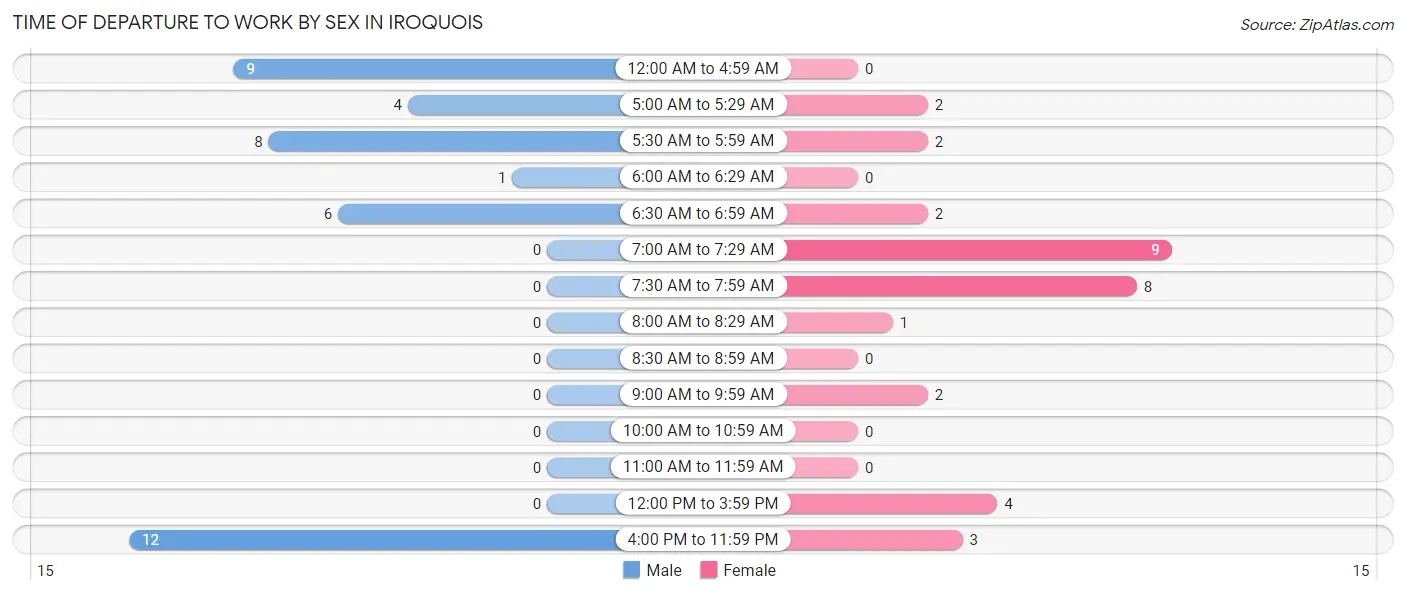
| Time of Departure | Male | Female |
| 12:00 AM to 4:59 AM | 9 (22.5%) | 0 (0.0%) |
| 5:00 AM to 5:29 AM | 4 (10.0%) | 2 (6.1%) |
| 5:30 AM to 5:59 AM | 8 (20.0%) | 2 (6.1%) |
| 6:00 AM to 6:29 AM | 1 (2.5%) | 0 (0.0%) |
| 6:30 AM to 6:59 AM | 6 (15.0%) | 2 (6.1%) |
| 7:00 AM to 7:29 AM | 0 (0.0%) | 9 (27.3%) |
| 7:30 AM to 7:59 AM | 0 (0.0%) | 8 (24.2%) |
| 8:00 AM to 8:29 AM | 0 (0.0%) | 1 (3.0%) |
| 8:30 AM to 8:59 AM | 0 (0.0%) | 0 (0.0%) |
| 9:00 AM to 9:59 AM | 0 (0.0%) | 2 (6.1%) |
| 10:00 AM to 10:59 AM | 0 (0.0%) | 0 (0.0%) |
| 11:00 AM to 11:59 AM | 0 (0.0%) | 0 (0.0%) |
| 12:00 PM to 3:59 PM | 0 (0.0%) | 4 (12.1%) |
| 4:00 PM to 11:59 PM | 12 (30.0%) | 3 (9.1%) |
| Total | 40 (100.0%) | 33 (100.0%) |
Housing Occupancy in Iroquois
Occupancy by Ownership in Iroquois
Of the total 94 dwellings in Iroquois, owner-occupied units account for 82 (87.2%), while renter-occupied units make up 12 (12.8%).

| Occupancy | # Housing Units | % Housing Units |
| Owner Occupied Housing Units | 82 | 87.2% |
| Renter-Occupied Housing Units | 12 | 12.8% |
| Total Occupied Housing Units | 94 | 100.0% |
Occupancy by Household Size in Iroquois

| Household Size | # Housing Units | % Housing Units |
| 1-Person Household | 27 | 28.7% |
| 2-Person Household | 34 | 36.2% |
| 3-Person Household | 4 | 4.3% |
| 4+ Person Household | 29 | 30.8% |
| Total Housing Units | 94 | 100.0% |
Occupancy by Ownership by Household Size in Iroquois

| Household Size | Owner-occupied | Renter-occupied |
| 1-Person Household | 22 (81.5%) | 5 (18.5%) |
| 2-Person Household | 34 (100.0%) | 0 (0.0%) |
| 3-Person Household | 1 (25.0%) | 3 (75.0%) |
| 4+ Person Household | 25 (86.2%) | 4 (13.8%) |
| Total Housing Units | 82 (87.2%) | 12 (12.8%) |
Occupancy by Educational Attainment in Iroquois

| Household Size | Owner-occupied | Renter-occupied |
| Less than High School | 2 (100.0%) | 0 (0.0%) |
| High School Diploma | 58 (96.7%) | 2 (3.3%) |
| College/Associate Degree | 18 (64.3%) | 10 (35.7%) |
| Bachelor's Degree or higher | 4 (100.0%) | 0 (0.0%) |
Occupancy by Age of Householder in Iroquois

| Age Bracket | # Households | % Households |
| Under 35 Years | 10 | 10.6% |
| 35 to 44 Years | 2 | 2.1% |
| 45 to 54 Years | 37 | 39.4% |
| 55 to 64 Years | 19 | 20.2% |
| 65 to 74 Years | 13 | 13.8% |
| 75 to 84 Years | 13 | 13.8% |
| 85 Years and Over | 0 | 0.0% |
| Total | 94 | 100.0% |
Housing Finances in Iroquois
Median Income by Occupancy in Iroquois

| Occupancy Type | # Households | Median Income |
| Owner-Occupied | 82 (87.2%) | $65,000 |
| Renter-Occupied | 12 (12.8%) | $0 |
| Average | 94 (100.0%) | $60,000 |
Occupancy by Householder Income Bracket in Iroquois
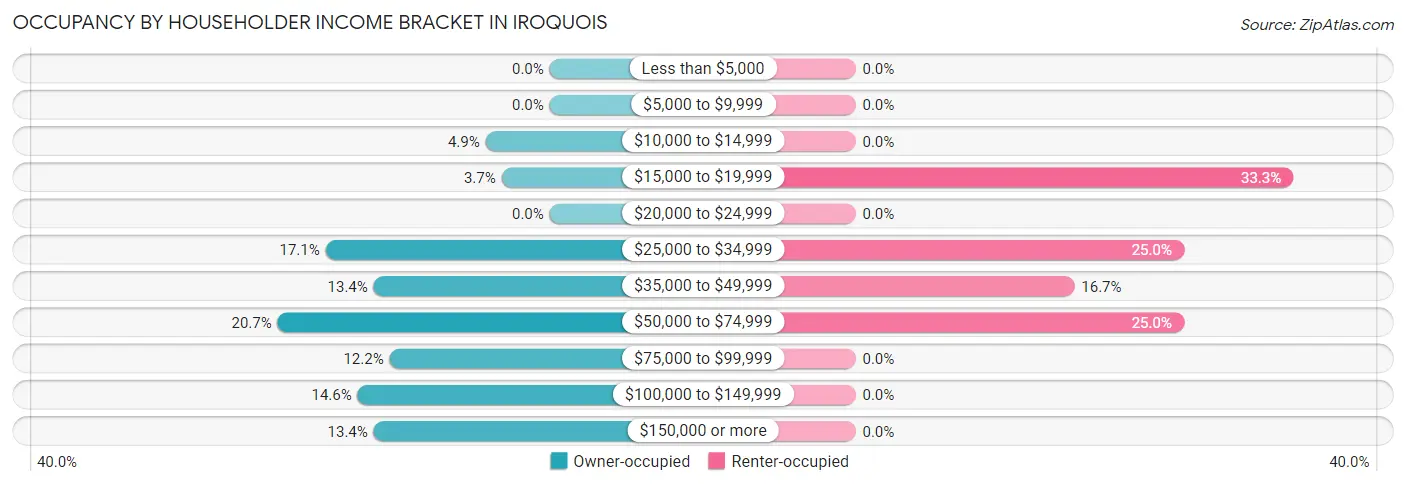
| Income Bracket | Owner-occupied | Renter-occupied |
| Less than $5,000 | 0 (0.0%) | 0 (0.0%) |
| $5,000 to $9,999 | 0 (0.0%) | 0 (0.0%) |
| $10,000 to $14,999 | 4 (4.9%) | 0 (0.0%) |
| $15,000 to $19,999 | 3 (3.7%) | 4 (33.3%) |
| $20,000 to $24,999 | 0 (0.0%) | 0 (0.0%) |
| $25,000 to $34,999 | 14 (17.1%) | 3 (25.0%) |
| $35,000 to $49,999 | 11 (13.4%) | 2 (16.7%) |
| $50,000 to $74,999 | 17 (20.7%) | 3 (25.0%) |
| $75,000 to $99,999 | 10 (12.2%) | 0 (0.0%) |
| $100,000 to $149,999 | 12 (14.6%) | 0 (0.0%) |
| $150,000 or more | 11 (13.4%) | 0 (0.0%) |
| Total | 82 (100.0%) | 12 (100.0%) |
Monthly Housing Cost Tiers in Iroquois

| Monthly Cost | Owner-occupied | Renter-occupied |
| Less than $300 | 8 (9.8%) | 0 (0.0%) |
| $300 to $499 | 21 (25.6%) | 0 (0.0%) |
| $500 to $799 | 22 (26.8%) | 3 (25.0%) |
| $800 to $999 | 8 (9.8%) | 2 (16.7%) |
| $1,000 to $1,499 | 22 (26.8%) | 7 (58.3%) |
| $1,500 to $1,999 | 0 (0.0%) | 0 (0.0%) |
| $2,000 to $2,499 | 0 (0.0%) | 0 (0.0%) |
| $2,500 to $2,999 | 0 (0.0%) | 0 (0.0%) |
| $3,000 or more | 1 (1.2%) | 0 (0.0%) |
| Total | 82 (100.0%) | 12 (100.0%) |
Physical Housing Characteristics in Iroquois
Housing Structures in Iroquois

| Structure Type | # Housing Units | % Housing Units |
| Single Unit, Detached | 93 | 98.9% |
| Single Unit, Attached | 1 | 1.1% |
| 2 Unit Apartments | 0 | 0.0% |
| 3 or 4 Unit Apartments | 0 | 0.0% |
| 5 to 9 Unit Apartments | 0 | 0.0% |
| 10 or more Apartments | 0 | 0.0% |
| Mobile Home / Other | 0 | 0.0% |
| Total | 94 | 100.0% |
Housing Structures by Occupancy in Iroquois

| Structure Type | Owner-occupied | Renter-occupied |
| Single Unit, Detached | 81 (87.1%) | 12 (12.9%) |
| Single Unit, Attached | 1 (100.0%) | 0 (0.0%) |
| 2 Unit Apartments | 0 (0.0%) | 0 (0.0%) |
| 3 or 4 Unit Apartments | 0 (0.0%) | 0 (0.0%) |
| 5 to 9 Unit Apartments | 0 (0.0%) | 0 (0.0%) |
| 10 or more Apartments | 0 (0.0%) | 0 (0.0%) |
| Mobile Home / Other | 0 (0.0%) | 0 (0.0%) |
| Total | 82 (87.2%) | 12 (12.8%) |
Housing Structures by Number of Rooms in Iroquois

| Number of Rooms | Owner-occupied | Renter-occupied |
| 1 Room | 0 (0.0%) | 0 (0.0%) |
| 2 or 3 Rooms | 0 (0.0%) | 0 (0.0%) |
| 4 or 5 Rooms | 34 (41.5%) | 9 (75.0%) |
| 6 or 7 Rooms | 22 (26.8%) | 3 (25.0%) |
| 8 or more Rooms | 26 (31.7%) | 0 (0.0%) |
| Total | 82 (100.0%) | 12 (100.0%) |
Housing Structure by Heating Type in Iroquois

| Heating Type | Owner-occupied | Renter-occupied |
| Utility Gas | 77 (93.9%) | 9 (75.0%) |
| Bottled, Tank, or LP Gas | 3 (3.7%) | 0 (0.0%) |
| Electricity | 2 (2.4%) | 3 (25.0%) |
| Fuel Oil or Kerosene | 0 (0.0%) | 0 (0.0%) |
| Coal or Coke | 0 (0.0%) | 0 (0.0%) |
| All other Fuels | 0 (0.0%) | 0 (0.0%) |
| No Fuel Used | 0 (0.0%) | 0 (0.0%) |
| Total | 82 (100.0%) | 12 (100.0%) |
Household Vehicle Usage in Iroquois

| Vehicles per Household | Owner-occupied | Renter-occupied |
| No Vehicle | 0 (0.0%) | 0 (0.0%) |
| 1 Vehicle | 11 (13.4%) | 9 (75.0%) |
| 2 Vehicles | 27 (32.9%) | 0 (0.0%) |
| 3 or more Vehicles | 44 (53.7%) | 3 (25.0%) |
| Total | 82 (100.0%) | 12 (100.0%) |
Real Estate & Mortgages in Iroquois
Real Estate and Mortgage Overview in Iroquois
| Characteristic | Without Mortgage | With Mortgage |
| Housing Units | 41 | 41 |
| Median Property Value | $87,000 | $96,300 |
| Median Household Income | $54,688 | $8 |
| Monthly Housing Costs | $446 | $1 |
| Real Estate Taxes | $1,750 | $0 |
Property Value by Mortgage Status in Iroquois

| Property Value | Without Mortgage | With Mortgage |
| Less than $50,000 | 14 (34.2%) | 7 (17.1%) |
| $50,000 to $99,999 | 11 (26.8%) | 18 (43.9%) |
| $100,000 to $299,999 | 14 (34.2%) | 16 (39.0%) |
| $300,000 to $499,999 | 1 (2.4%) | 0 (0.0%) |
| $500,000 to $749,999 | 0 (0.0%) | 0 (0.0%) |
| $750,000 to $999,999 | 1 (2.4%) | 0 (0.0%) |
| $1,000,000 or more | 0 (0.0%) | 0 (0.0%) |
| Total | 41 (100.0%) | 41 (100.0%) |
Household Income by Mortgage Status in Iroquois

| Household Income | Without Mortgage | With Mortgage |
| Less than $10,000 | 0 (0.0%) | 2 (4.9%) |
| $10,000 to $24,999 | 7 (17.1%) | 0 (0.0%) |
| $25,000 to $34,999 | 3 (7.3%) | 0 (0.0%) |
| $35,000 to $49,999 | 7 (17.1%) | 11 (26.8%) |
| $50,000 to $74,999 | 14 (34.2%) | 4 (9.8%) |
| $75,000 to $99,999 | 2 (4.9%) | 3 (7.3%) |
| $100,000 to $149,999 | 5 (12.2%) | 8 (19.5%) |
| $150,000 or more | 3 (7.3%) | 7 (17.1%) |
| Total | 41 (100.0%) | 41 (100.0%) |
Property Value to Household Income Ratio in Iroquois

| Value-to-Income Ratio | Without Mortgage | With Mortgage |
| Less than 2.0x | 25 (61.0%) | 93,036 (226,917.1%) |
| 2.0x to 2.9x | 4 (9.8%) | 29 (70.7%) |
| 3.0x to 3.9x | 5 (12.2%) | 11 (26.8%) |
| 4.0x or more | 7 (17.1%) | 1 (2.4%) |
| Total | 41 (100.0%) | 41 (100.0%) |
Real Estate Taxes by Mortgage Status in Iroquois

| Property Taxes | Without Mortgage | With Mortgage |
| Less than $800 | 15 (36.6%) | 0 (0.0%) |
| $800 to $1,499 | 5 (12.2%) | 2 (4.9%) |
| $800 to $1,499 | 21 (51.2%) | 25 (61.0%) |
| Total | 41 (100.0%) | 41 (100.0%) |
Health & Disability in Iroquois
Health Insurance Coverage by Age in Iroquois

| Age Bracket | With Coverage | Without Coverage |
| Under 6 Years | 19 (100.0%) | 0 (0.0%) |
| 6 to 18 Years | 57 (100.0%) | 0 (0.0%) |
| 19 to 25 Years | 7 (100.0%) | 0 (0.0%) |
| 26 to 34 Years | 10 (100.0%) | 0 (0.0%) |
| 35 to 44 Years | 20 (74.1%) | 7 (25.9%) |
| 45 to 54 Years | 43 (95.6%) | 2 (4.4%) |
| 55 to 64 Years | 30 (93.8%) | 2 (6.2%) |
| 65 to 74 Years | 28 (100.0%) | 0 (0.0%) |
| 75 Years and older | 19 (100.0%) | 0 (0.0%) |
| Total | 233 (95.5%) | 11 (4.5%) |
Health Insurance Coverage by Citizenship Status in Iroquois

| Citizenship Status | With Coverage | Without Coverage |
| Native Born | 19 (100.0%) | 0 (0.0%) |
| Foreign Born, Citizen | 57 (100.0%) | 0 (0.0%) |
| Foreign Born, not a Citizen | 7 (100.0%) | 0 (0.0%) |
Health Insurance Coverage by Household Income in Iroquois

| Household Income | With Coverage | Without Coverage |
| Under $25,000 | 25 (100.0%) | 0 (0.0%) |
| $25,000 to $49,999 | 37 (100.0%) | 0 (0.0%) |
| $50,000 to $74,999 | 41 (83.7%) | 8 (16.3%) |
| $75,000 to $99,999 | 63 (100.0%) | 0 (0.0%) |
| $100,000 and over | 67 (95.7%) | 3 (4.3%) |
Public vs Private Health Insurance Coverage by Age in Iroquois

| Age Bracket | Public Insurance | Private Insurance |
| Under 6 | 9 (47.4%) | 10 (52.6%) |
| 6 to 18 Years | 12 (21.0%) | 49 (86.0%) |
| 19 to 25 Years | 6 (85.7%) | 3 (42.9%) |
| 25 to 34 Years | 4 (40.0%) | 6 (60.0%) |
| 35 to 44 Years | 4 (14.8%) | 19 (70.4%) |
| 45 to 54 Years | 21 (46.7%) | 28 (62.2%) |
| 55 to 64 Years | 8 (25.0%) | 26 (81.2%) |
| 65 to 74 Years | 28 (100.0%) | 11 (39.3%) |
| 75 Years and over | 19 (100.0%) | 15 (78.9%) |
| Total | 111 (45.5%) | 167 (68.4%) |
Disability Status by Sex by Age in Iroquois

| Age Bracket | Male | Female |
| Under 5 Years | 0 (0.0%) | 0 (0.0%) |
| 5 to 17 Years | 0 (0.0%) | 0 (0.0%) |
| 18 to 34 Years | 2 (28.6%) | 2 (11.8%) |
| 35 to 64 Years | 7 (12.3%) | 2 (4.3%) |
| 65 to 74 Years | 9 (52.9%) | 0 (0.0%) |
| 75 Years and over | 3 (37.5%) | 7 (63.6%) |
Disability Class by Sex by Age in Iroquois
Disability Class: Hearing Difficulty

| Age Bracket | Male | Female |
| Under 5 Years | 0 (0.0%) | 0 (0.0%) |
| 5 to 17 Years | 0 (0.0%) | 0 (0.0%) |
| 18 to 34 Years | 2 (28.6%) | 0 (0.0%) |
| 35 to 64 Years | 5 (8.8%) | 0 (0.0%) |
| 65 to 74 Years | 7 (41.2%) | 0 (0.0%) |
| 75 Years and over | 3 (37.5%) | 6 (54.5%) |
Disability Class: Vision Difficulty

| Age Bracket | Male | Female |
| Under 5 Years | 0 (0.0%) | 0 (0.0%) |
| 5 to 17 Years | 0 (0.0%) | 0 (0.0%) |
| 18 to 34 Years | 0 (0.0%) | 0 (0.0%) |
| 35 to 64 Years | 0 (0.0%) | 0 (0.0%) |
| 65 to 74 Years | 0 (0.0%) | 0 (0.0%) |
| 75 Years and over | 2 (25.0%) | 0 (0.0%) |
Disability Class: Cognitive Difficulty

| Age Bracket | Male | Female |
| 5 to 17 Years | 0 (0.0%) | 0 (0.0%) |
| 18 to 34 Years | 0 (0.0%) | 0 (0.0%) |
| 35 to 64 Years | 0 (0.0%) | 2 (4.3%) |
| 65 to 74 Years | 0 (0.0%) | 0 (0.0%) |
| 75 Years and over | 1 (12.5%) | 0 (0.0%) |
Disability Class: Ambulatory Difficulty

| Age Bracket | Male | Female |
| 5 to 17 Years | 0 (0.0%) | 0 (0.0%) |
| 18 to 34 Years | 0 (0.0%) | 2 (11.8%) |
| 35 to 64 Years | 2 (3.5%) | 2 (4.3%) |
| 65 to 74 Years | 2 (11.8%) | 0 (0.0%) |
| 75 Years and over | 2 (25.0%) | 1 (9.1%) |
Disability Class: Self-Care Difficulty

| Age Bracket | Male | Female |
| 5 to 17 Years | 0 (0.0%) | 0 (0.0%) |
| 18 to 34 Years | 0 (0.0%) | 2 (11.8%) |
| 35 to 64 Years | 0 (0.0%) | 2 (4.3%) |
| 65 to 74 Years | 0 (0.0%) | 0 (0.0%) |
| 75 Years and over | 0 (0.0%) | 0 (0.0%) |
Technology Access in Iroquois
Computing Device Access in Iroquois

| Device Type | # Households | % Households |
| Desktop or Laptop | 71 | 75.5% |
| Smartphone | 79 | 84.0% |
| Tablet | 50 | 53.2% |
| No Computing Device | 10 | 10.6% |
| Total | 94 | 100.0% |
Internet Access in Iroquois

| Internet Type | # Households | % Households |
| Dial-Up Internet | 0 | 0.0% |
| Broadband Home | 40 | 42.5% |
| Cellular Data Only | 12 | 12.8% |
| Satellite Internet | 37 | 39.4% |
| No Internet | 17 | 18.1% |
| Total | 94 | 100.0% |
Iroquois Summary
Iroquois is a small village located in Iroquois County, Illinois, United States. The population was 1,093 at the 2010 census. It is part of the Kankakee–Bradley Metropolitan Statistical Area.
History
The area that is now Iroquois was first settled in 1835 by a group of French-Canadian immigrants. The village was originally known as "L'Eglise de St. Pierre" (St. Peter's Church) and was located near the Iroquois River. The name was changed to Iroquois in 1854 when the post office was established.
The village was incorporated in 1872 and was the first incorporated village in Iroquois County. The village was named after the Iroquois Native American tribe, which had inhabited the area prior to European settlement.
Geography
Iroquois is located at 40 59 25 North 87 51 45 West 40 990278 87 862472
According to the 2010 census the village has a total area of 0 7 square miles 1 8 km2 all land
Economy
The economy of Iroquois is largely based on agriculture. The village is home to several farms, including a dairy farm, a hog farm, and a grain farm. The village also has a few small businesses, including a grocery store, a hardware store, and a restaurant.
Demographics
As of the census of 2010, there were 1,093 people, 441 households, and 294 families residing in the village. The population density was 1,541.4 people per square mile (595.3/km2). There were 471 housing units at an average density of 667.1 per square mile (257.7/km2). The racial makeup of the village was 97.2% White, 0.2% African American, 0.2% Native American, 0.2% Asian, 0.2% from other races, and 1.9% from two or more races. Hispanic or Latino of any race were 1.3% of the population.
There were 441 households, out of which 32.2% had children under the age of 18 living with them, 51.6% were married couples living together, 10.2% had a female householder with no husband present, and 33.2% were non-families. 28.7% of all households were made up of individuals, and 14.3% had someone living alone who was 65 years of age or older. The average household size was 2.48 and the average family size was 3.04.
In the village, the population was spread out, with 25.7% under the age of 18, 8.2% from 18 to 24, 28.2% from 25 to 44, 22.2% from 45 to 64, and 15.7% who were 65 years of age or older. The median age was 37 years. For every 100 females, there were 97.2 males. For every 100 females age 18 and over, there were 94.2 males.
The median income for a household in the village was $37,500, and the median income for a family was $45,000. Males had a median income of $31,250 versus $21,250 for females. The per capita income for the village was $17,845. About 6.2% of families and 8.2% of the population were below the poverty line, including 10.2% of those under age 18 and 8.2% of those age 65 or over.
Common Questions
What is Per Capita Income in Iroquois?
Per Capita income in Iroquois is $26,994.
What is the Median Family Income in Iroquois?
Median Family Income in Iroquois is $83,750.
What is the Median Household income in Iroquois?
Median Household Income in Iroquois is $60,000.
What is Income or Wage Gap in Iroquois?
Income or Wage Gap in Iroquois is 59.9%.
Women in Iroquois earn 40.1 cents for every dollar earned by a man.
What is Inequality or Gini Index in Iroquois?
Inequality or Gini Index in Iroquois is 0.37.
What is the Total Population of Iroquois?
Total Population of Iroquois is 244.
What is the Total Male Population of Iroquois?
Total Male Population of Iroquois is 95.
What is the Total Female Population of Iroquois?
Total Female Population of Iroquois is 149.
What is the Ratio of Males per 100 Females in Iroquois?
There are 63.76 Males per 100 Females in Iroquois.
What is the Ratio of Females per 100 Males in Iroquois?
There are 156.84 Females per 100 Males in Iroquois.
What is the Median Population Age in Iroquois?
Median Population Age in Iroquois is 45.5 Years.
What is the Average Family Size in Iroquois
Average Family Size in Iroquois is 3.0 People.
What is the Average Household Size in Iroquois
Average Household Size in Iroquois is 2.6 People.
How Large is the Labor Force in Iroquois?
There are 73 People in the Labor Forcein in Iroquois.
What is the Percentage of People in the Labor Force in Iroquois?
41.7% of People are in the Labor Force in Iroquois.